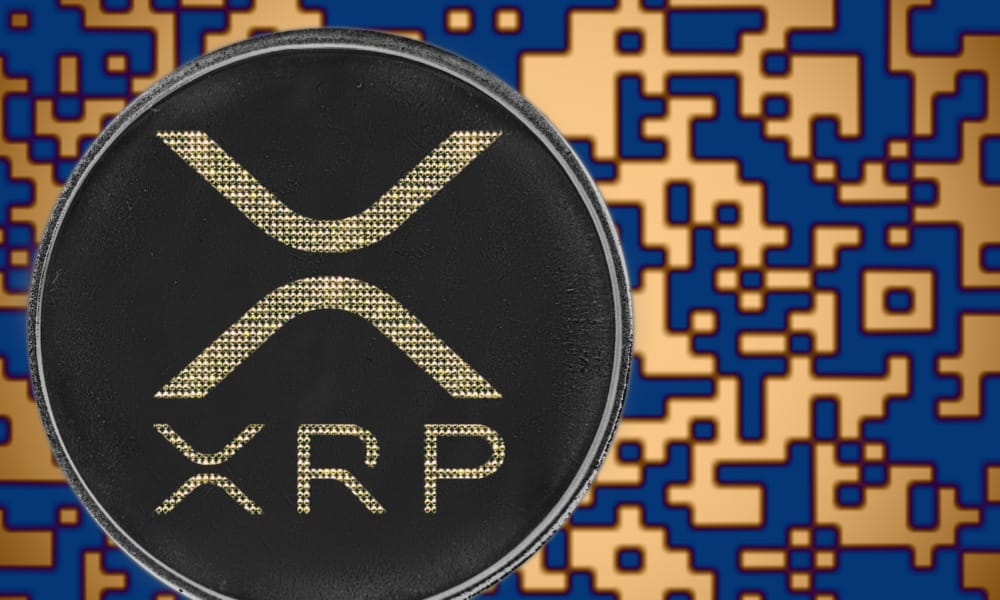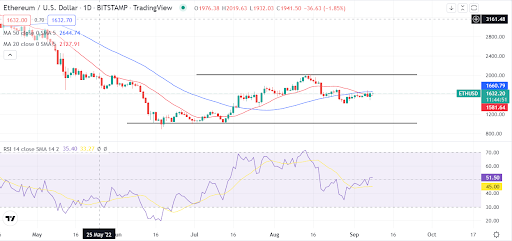Discovered this on the Net – https://isethereumasecurity.com/
Is Ethereum a Safety?
The query of if Ethereum is a safety has been a subject of scorching debate, particularly as Ethereum transitioned to “Proof-of-Stake” a mannequin through which customers stake their Ether on a validator and participate in rewards for validating the community.In an effort to reply if Ethereum is a safety, at the least within the eyes of US regulators, we should view it by means of the lens of a take a look at often known as the “Howey Take a look at” which is a three-pronged1 that determines if Ethereum is a safety.It needs to be famous that all three prongs of the take a look at have to be met for one thing to be deemed a safety.We will evaluate the weather of the take a look at individually:
1. An funding of cash:
Prong #1 is straightforward and doesn’t require debate. Ethereum does meet this standards in a Proof-of-Stake mannequin and requires a person shopping for or buying Ethereum to participate in staking.
The phrase “cash” doesn’t negate or by-pass this prong.
The case “State V Gopher Tire and Rubber Co”2 the courtroom notes that “laying out of capital in a method meant to safe revenue or employement” is adequate to fulfill this prong.
It’s also famous in “Uselton v. Industrial Lovelace Motor Freight”3 the courtroom expressly discovered that the “funding of cash” can take the types of “items or companies” or one other “trade of worth.”
Lastly, in “SEC v. Shavers”4 the courtroom expressly discovered that Bitcoin and different digital currencies might meet the usual of “an funding of cash.”
Standing: Meets this Prong
2. In a typical enteprise:
In an effort to evaluate this prong one wants to grasp:
The brief abstract of the Ethereum Validation system is:
Your funds are usually not pooled with different stakers.
In case your validator is slashed solely you obtain a penalty.
Penalties happen if are offline too lengthy (failed technical effort) or in case you are malicious.
You might be solely rewarded based mostly on the position of your validator.
Validators are rewarded for reporting slashable offenses, making them adversarial and never communal.
Particular person block proposers revenue from prolonged effort resembling MEV that isn’t shared by others.In line which every framing of frequent enterprise:
Horizontal Commonality:
As outlined in “Revak v SEC Realty Corp”5 the courtroom appears for “the pro-rata distribution of earnings” and the “tying collectively of traders belongings, through the pooling of funds.”
In “Hart v. Pulte Properties of Michigan Corp”6 and “Salcer v. Merrill Lync, Pierce, Fenner & Smith Inc”7 the courts expressly counsel that the “funding should be a part of a pooled group of funds.”
And in “Milnarik v M-S Commodities”8 it’s famous that “the success or failure of different contracts should have a direct influence on the profitability of plantiffs contracts.”
Since our Ethereum shouldn’t be pooled and a validators revenue or penalty is derived solely from their efficiency and doesn’t influence different validators, we are able to conclude there’s not “Horizontal Commonality.”
Vertical Commonality:
As outlined in “SEC v. Glenn W Turner Enters Inc”9 vertical commonality requires the traders earnings are “tied inextricably to the efficacy of the promoter”
In “Villeneuve v. Superior Bus Ideas Corp”10 its famous that “the fortunes of traders want be linked solely to the efforts of the promoter” and in “Lengthy v. Shultz Cattle Co”11 expanded to notice that it requires solely that the “fortunes of invesntors be tied to the fortunes of the promoters.”
First there’s the problem that it isn’t possible that there’s grounds to search out that there’s an “Ethereum Promoter” any extra beneath the definition of this position. But, that’s novel authorized precedent that might have to be examined.
As an alternative, if we assume the Ethereum creators have been discovered to be “Promoters” for sake of the arguement, then the query is that if their fortune is straight tied to the fortunes of the “traders.”
By contributing to Ethereum, builders don’t expressly personal a part of the community except they themselves bought Ether. As such, they can’t be deemed to be a promoter.
Commonality
The one commonality arguement that exists is that there’s some form of “frequent enterprise” amongst validators operating the community, and a cooperative mechanic between validators validating a transaction. Nonetheless, as these are distinct and put up facto to the event of the networks code, these validators can not sufficiently be discovered to be “promoters” in any established sense of the time period.
Standing: Doesn’t this Prong
3. An expectation of revenue, derived from the efforts of others:
The ultimate prong of the Howey Take a look at is that if the investor can have “an expectation of revenue, derived from the efforts of others.”
As outlined in “How Many Prongs Are In The Howey Take a look at?” you will need to word that this clause is a compound as a result of:
Customers are allowed to count on revenue, and,
The frequent enterprise might have efforts of others.
However, the revenue should not be derived from the efforts of others.
In “United Housing Basis v. Forman”12 the courts expressly famous that the core of that is based mostly “on an affordable expectation of earnings to be derived from the entrepreneurial or mangerial efforts of others.”
This requires that we should not solely count on revenue, however the revenue we count on have to be from the efforts of others and never be from our personal efforts or items.
In “US v. Holtzclaw”13 a church purchased right into a program to resell gold certificates from the “Promote America” program, the courts discovered {that a} multi-level advertising program was not a safety for the aggreved social gathering, as they solely earned from gross sales ensuing from their very own efforts.
Whereas the “efforts of others” have been completely wanted to ensure that their to be revenue (Promote America needed to purchase gold, concern certificates, create a system to promote and register these and redeem them) the revenue anticipated didn’t stem from these efforts and required the efforts of the investor social gathering to be promoting.
As talked about within the abstract of Ethereum Validation and Ethereum Rewards & Penalties, we all know that:
Validators should use their very own technical experience to keep up ample know-how and uptime.
Their validator is solely rewarded when it takes half in validation.
Their validator solely earns a reward or penalty, for itself, based mostly by itself actions.
A validtor can improve their earnings, and solely their earnings by means of implementing MEV methods.
Validators can improve their earnings by reporting unhealthy validators within the set, making clear that the validator “committee” shouldn’t be a typical enterprise with earnings tied to one another, however as an alternative an seperate and adverseral set of distributors.
In principle a single validator may very well be rewarded if no different validator took half within the course of, displaying there’s not a dependence on actions of others.
In the end this prong of the Howey Take a look at posits the query “What are you being rewarded for?.”
Within the Ethereum community, you as a validator are usually not rewarded on the idea that the Ethereum builders proceed to develop.
Validators are promoting “dependable participation”, they’re rewarded for being obtainable and correct. We all know this as a result of a validator is slashed when it has extreme downtime, or its belief turns into poor and it’s slashed on a person stage.
If we’re rewarded for “dependable participation” and slashed when and solely when we now have both downtime or lose belief, then this have to be what’s on the market.
The query then turns into is the hassle of sustaining that “dependable participation” by sustaining a validator adequate that we’re being clearly rewarded for our personal particular person actions somewhat than the efforts of others?
We imagine the SEC has not directly answered that for us already in “SEC v. Homero Joshua Garza”14 through which Garza was charged with violating part 5a of the Securities Legislation Act of 1933.
On this case, the SEC considered that proudly owning and managing Bitcoin mining rigs/servers was a managerial effort, and that promoting entry to their future earnings was due to this fact a matter of expectation of revenue on the efforts of others and thus a safety.
Subsequently we imagine it’s plain that the sustaining of an Ethereum validator which has the extra burden and complexity of uptime and accuracy necessities, also needs to be considered as the important thing managerial effort, and due to this fact doesn’t meet this prong.
Standing: Doesn’t this Prong
Abstract:
Prong #2:
Arduous to counsel there’s an “issuer” or “promoter” at this level in Ethereum.
Staking doesn’t have horizontal commonality in relation to earnings.
Staking does have some horizontal commonality in relation to different validators, however they don’t seem to be an issuer/promoter.
Horziontal commonality in efforts is negated by the issue that the earnings and loses are solely based mostly by yourself validators efficiency and actions.
Your validator may be taken to a different community shouldn’t be locked in to any sort of commonality.
Staking doesn’t have robust vertical commonality with the issuer.
There’s solely broad vertical commonality, in the event you imagine what’s being bought is blockspace, and that the blockspace is owned by builders who publish code, however don’t run the community.
Prong #3:
There’s an expectation of earnings.
These earnings are solely derived from your personal means to keep up a dependable validator.
The upkeep of a machine performing community validation has been proven to be a key managerial effort prior to now.
You might be promoting uptime and validation, and never blockspace, as your validator might join to a different PoS community, or fork, with different validators and do the identical motion.
This is able to imply discovering Ethereum Proof-of-Stake to not be a safety.
Widespread Arguements Debunked:
How Many Prongs Are In The Howey Take a look at? ↩
Searching for non-secondary hyperlink to case ↩
Uselton v. Industrial Lovelace Motor Freight ↩
SEC v. Shavers ↩
Revak v. SEC Realty Corp ↩
Hart v. Pulte Properties of Michigan Corp ↩
Salcer v. Merrill Lynch, Pierce, Fenner ↩
Milnarik v. M-S Commodities, Inc. ↩
SEC v. Glenn W. Turner Enters., Inc ↩
Villeneuve v. Superior Bus. Ideas Corp. ↩
Lengthy v. Shultz Cattle Co, inc. ↩
United Housing Basis, Inc V. Forman ↩
US v. Holtzclaw ↩
SEC v. Homero Joshua Garza” ↩
Edit: TL:DR No, Eth shouldn’t be a safety.
























